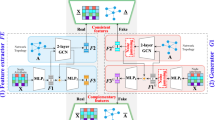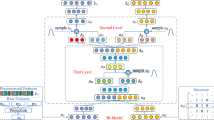Abstract
Attributed graph embedding aims to learn low-dimensional representations by fully exploiting both topological structure and rich attributes. The embeddings contain more useful information, thus yielding better performance in subsequent analysis tasks. Therefore, attributed network embedding has become an important research direction in recent years. However, most existing algorithms ignore the high-frequency noise contained in the features and do not normalize the embedding, which limits their performance in downstream tasks. To solve the above problem, we design an Adversarial Attributed Graph Embedding algorithm (AAGE) in conjunction with a Laplacian smoothing filter. In particular, the AAGE employs a variational autoencoder (VAE) to learn the embedding of nodes and attributes. Unlike most variational autoencoder-based algorithms, we first apply a carefully-designed Laplacian filter to smooth the features before performing autoencoder, secondly normalize the obtained embeddings of nodes and attributes during the autoencoder process, and finally devise a generative adversarial training method to enhance the robustness of the learned representations. To verify the potential of the proposed AAGE, we evaluate its performance on the tasks of node classification and node clustering on three real-world attributed networks. The results show that AAGE significantly outperforms state-of-the-art methods.








Similar content being viewed by others
Data Availability
Datasets derived from public resources and made available with the article: Kipf, T.N., Welling, M.: Semi-supervised classification with graph convolutional networks. In: Proceedings of the 5th International Conference on Learning Representations (2017).
References
Wu Z, Pan S, Chen F, Long G, Zhang C, Philip SY (2020) A comprehensive survey on graph neural networks. IEEE Trans Neural Netw Learn Syst 32(1):4–24. https://doi.org/10.1109/TNNLS.2020.2978386
Zhou H, Gong M, Wang S, Gao Y, Zhao Z (2023) Smgcl: Semi-supervised multi-view graph contrastive learning. Knowl-Based Syst 260:110120. https://doi.org/10.1016/j.knosys.2022.110120
Duan Y, Huang H, Wang T (2021) Semi-supervised feature extraction of hyperspectral image using nonlinear geodesic sparse hypergraphs. IEEE Trans Geosci Remote Sens 60:1–15. https://doi.org/10.1109/TGRS.2021.3110855
Luo F, Zou Z, Liu J, Lin Z (2021) Dimensionality reduction and classification of hyperspectral image via multistructure unified discriminative embedding. IEEE Trans Geosci Remote Sens 60:1–16. https://doi.org/10.1109/TGRS.2021.3128764
Wang X, Bo D, Shi C, Fan S, Ye Y, Yu PS (2023) A survey on heterogeneous graph embedding: Methods, techniques, applications and sources. IEEE Trans Big Data 9(2):415–436. https://doi.org/10.1109/TBDATA.2022.3177455
(2020) Graph neural networks: A review of methods and applications. AI Open 1:57–81. https://doi.org/10.1016/j.aiopen.2021.01.001
Hsieh I, Li C (2023) CoANE: Modeling context co-occurrence for attributed network embedding. IEEE Trans Knowl Data Eng 35(1):167–180. https://doi.org/10.1109/TKDE.2021.3079498
Tu C, Zhang W, Liu Z, Sun M (2016) Max-margin deepwalk: discriminative learning of network representation. In: Proceedings of the twenty-fifth international joint conference on artificial intelligence, pp 3889–3895. https://doi.org/10.5555/3061053.3061163
Li J, Peng H, Cao Y, Dou Y, Zhang H, Philip SY, He L (2021) Higherorder attribute-enhancing heterogeneous graph neural networks. IEEE Trans Knowl Data Eng 35(1):560–574. https://doi.org/10.1109/TKDE.2021.3074654
Kipf TN, Welling M (2016) Variational graph auto-encoders. arXiv preprint arXiv:1611.07308. https://doi.org/10.48550/arXiv.1611.07308
Wei M, Wu J, Yang L, Tang Y (2021) Matrix factorization with dual-network collaborative embedding for social recommendation. Int J Wavelets Multiresolution Inf Process 19(5):2150016–1215001615. https://doi.org/10.1142/S0219691321500168
Yang C, Liu Z, Zhao D, Sun M, Chang EY (2015) Network representation learning with rich text information. In: Proceedings of the twenty-fourth international joint conference on artificial intelligence, pp 2111–2117. https://doi.org/10.5555/2832415.2832542
Gong M, Zhou H, Qin AK, Liu W, Zhao Z (2022) Self-paced co-training of graph neural networks for semi-supervised node classification. IEEE Trans Neural Netw Learn Syst 1–14. https://doi.org/10.1109/TNNLS.2022.3157688
Hamilton WL, Ying R, Leskovec J (2017) Inductive representation learning on large graphs. In: Proceedings of the 31st international conference on neural information processing systems, pp 1025–1035. https://doi.org/10.5555/3294771.3294869
Velickovic P, Cucurull G, Casanova A, Romero A, Liò P, Bengio Y (2018) Graph attention networks. In: Proceedings of the 6th international conference on learning representations, pp 1–12. https://doi.org/10.48550/arXiv.1710.10903
Hong R, He Y, Wu L, Ge Y, Wu X (2019) Deep attributed network embedding by preserving structure and attribute information. IEEE Trans Syst Man Cybern Syst 51(3):1434–1445. https://doi.org/10.1109/TSMC.2019.2897152
Kingma DP, Welling M (2014) Auto-encoding variational bayes. In: Proceedings of the 2nd international conference on learning representations, pp 1–14. https://doi.org/10.48550/arXiv.1312.6114
Vaibhav, Huang P, Frederking RE (2019) RWR-GAE: random walk regularization for graph auto encoders. CoRR abs/1908.04003. https://doi.org/10.48550/arXiv.1908.04003
Meng Z, Liang S, Bao H, Zhang X (2019) Co-embedding attributed networks. In: Proceedings of the Twelfth ACM international conference on web search and data mining, pp 393–401. https://doi.org/10.1145/3289600.3291015
Pan S, Hu R, Long G, Jiang J, Yao L, Zhang C (2018) Adversarially regularized graph autoencoder for graph embedding. In: Proceedings of the 27th international joint conference on artificial intelligence, pp 2609–2615. https://doi.org/10.5555/3304889.3305023
Cui G, Zhou J, Yang C, Liu Z (2020) Adaptive graph encoder for attributed graph embedding. In: Proceedings of the 26th ACM SIGKDD international conference on knowledge discovery & data mining, pp 976–985. https://doi.org/10.1145/3394486.3403140
Kipf TN, Welling M (2017) Semi-supervised classification with graph convolutional networks. In: Proceedings of the 5th international conference on learning representations, pp 1–14. https://doi.org/10.48550/arXiv.1609.02907
Chen J, Ma T, Xiao C (2018) FastGCN: Fast learning with graph convolutional networks via importance sampling. In: Proceedings of the 6th international conference on learning representations, pp 1–15. https://doi.org/10.48550/arXiv.1801.10247
Lee JB, Rossi R, Kong X (2018) Graph classification using structural attention. In: Proceedings of the 24th ACM SIGKDD international conference on knowledge discovery & data mining, pp 1666–1674. https://doi.org/10.1145/3219819.3219980
Hasanzadeh A, Hajiramezanali E, Narayanan KR, Duffield N, Zhou M, Qian X (2019) Semi-implicit graph variational auto-encoders. In: Advances in neural information processing systems 32: Annual conference on neural information processing systems 2019, pp 10711–10722. https://doi.org/10.48550/arXiv.1908.07078
Gao H, Pei J, Huang H (2019) ProGAN: Network embedding via proximity generative adversarial network. In: Proceedings of the 25th ACM SIGKDD international conference on knowledge discovery & data mining, pp 1308–1316. https://doi.org/10.1145/3292500.3330866
You J, Ying R, Ren X, Hamilton WL, Leskovec J (2018) Graphrnn: Generating realistic graphs with deep auto-regressive models. In: Proceedings of the 35th international conference on machine learning, pp 5694–5703. https://doi.org/10.48550/arXiv.1802.08773
Gao H, Xiao J, Yin Y, Liu T, Shi J (2022) A mutually supervised graph attention network for few-shot segmentation: The perspective of fully utilizing limited samples. IEEE Trans Neural Netw Learn Syst 1–13. https://doi.org/10.1109/TNNLS.2022.3155486
Li R, Wang S, Zhu F, Huang J (2018) Adaptive graph convolutional neural networks. In: Proceedings of the AAAI conference on artificial intelligence, vol 32. https://doi.org/10.1609/aaai.v32i1.11691
Zhu Y, Xu Y, Yu F, Liu Q, Wu S, Wang L (2020) Deep graph contrastive representation learning. arXiv preprint arXiv:2006.04131. https://doi.org/10.48550/arXiv.2006.04131
Wang X, Qi G-J (2022) Contrastive learning with stronger augmentations. IEEE Trans Pattern Anal Mach Intell 45(5):5549–5560. https://doi.org/10.1109/TPAMI.2022.3203630
Gao H, Qiu B, Duran Barroso RJ, Hussain W, Xu Y, Wang X (2022) Tsmae: A novel anomaly detection approach for internet of things time series data using memory-augmented autoencoder. IEEE Trans Netw Sci Eng 1–14. https://doi.org/10.1109/TNSE.2022.3163144
Gao H, Huang J, Tao Y, Hussain W, Huang Y (2022) The joint method of triple attention and novel loss function for entity relation extraction in small data-driven computational social systems. IEEE Trans Comput Soc Syst 9(6):1725–1735. https://doi.org/10.1109/TCSS.2022.3178416
Goodfellow I, Pouget-Abadie J, Mirza M, Xu B, Warde-Farley D, Ozair S, Courville A, Bengio Y (2020) Generative adversarial networks. Commun of the ACM 63(11):139–144. https://doi.org/10.1145/3422622
Xiao Y, Xiao D, Hu B, Shi C ANE: Network embedding via adversarial autoencoders. In: Proceedings of the 2018 IEEE international conference on big data and smart computing (BigComp), pp 66–73. https://doi.org/10.1109/BigComp.2018.00019
Ding M, Tang J, Zhang J (2018) Semi-supervised learning on graphs with generative adversarial nets. In: Proceedings of the 27th ACM international conference on information and knowledge management, pp 913–922. https://doi.org/10.1145/3269206.3271768
Ai G, Yan H, Yang J, Li X (2021) Beyond laplacian smoothing for semisupervised community detection. In: Knowledge science, engineering and management: 14th international conference, pp 174–187. https://doi.org/10.1007/978-3-030-82153-1_15
Kingma D, Ba J (2015) Adam: A method for stochastic optimization. In: Proceedings of the 3rd international conference on learning representations, pp 1–15. https://doi.org/10.48550/arXiv.1412.6980
Acknowledgements
This research is supported by the National Natural Science Foundation of China (Grant No. 62072288, 61702306, 61433012), the Taishan Scholar Program of Shandong Province, Shandong Youth Innovation Team, the Natural Science Foundation of Shandong Province (Grant No. ZR2018BF013, ZR2022MF268), and the Open Project Foundation of Intelligent Information Processing Key Laboratory of Shanxi Province (Grant No. CICIP2020001).
Author information
Authors and Affiliations
Corresponding author
Ethics declarations
Conflict of Interests
The authors declare that they have no conflict of interest to this work.
Additional information
Publisher's Note
Springer Nature remains neutral with regard to jurisdictional claims in published maps and institutional affiliations.
Rights and permissions
Springer Nature or its licensor (e.g. a society or other partner) holds exclusive rights to this article under a publishing agreement with the author(s) or other rightsholder(s); author self-archiving of the accepted manuscript version of this article is solely governed by the terms of such publishing agreement and applicable law.
About this article
Cite this article
Zhou, H., Liu, X., Li, X. et al. Adversarial variational autoencoder for attributed graph embedding with high-frequency noise filtering. Appl Intell 53, 26750–26762 (2023). https://doi.org/10.1007/s10489-023-04961-2
Accepted:
Published:
Issue Date:
DOI: https://doi.org/10.1007/s10489-023-04961-2




